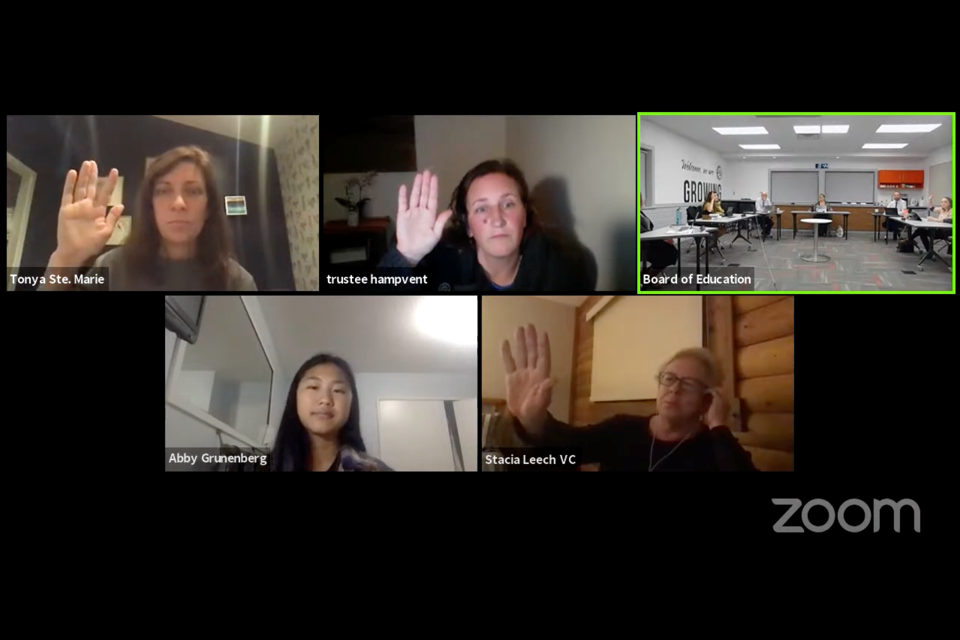Cleaning supplies, transportation, food and outdoor learning facilities are among the laundry-list of uses targeted for a $1.1-million windfall from the federal government to support Sunshine Coast schools this year as they adapt to the pandemic.
So far School District No. 46 (SD46) has received $578,000 from the federal government’s $2-billion Safe Return to School Fund and another roughly equal portion is expected midway through the school year, according to SD46 staff, who presented plans for spending the money at an Oct. 14 regular board meeting.
About $530,000 will be spent on cleaning and custodial needs including supplies and facility upgrades – all washroom faucets will be replaced with automatic shut-offs, for example – as well as sick leave costs, HVAC upgrades such as installing MERV 13 filters, “technology sanitation,” Plexiglass and personal protective equipment, and health and safety planning.
Another $560,000 will go towards outdoor learning facilities, school-specific outdoor learning, “school enrolment decline funding,” food supports, funding to support the district’s gradual return “transition phase” option, Indigenous education, “audio supports” and online learning.
A further $63,000 has been assigned for transportation improvements.
The funding was announced in early September and the district has until June 30, 2021 to spend it. Secretary-Treasurer Nicholas Weswick compared the unusual situation to “building the airplane midflight.”
“This is an accelerated process,” he said. “We haven’t had the same opportunity for consultation and discussion that we normally would have.”
Some stakeholders did provide input, though, including the school district’s Indigenous Advisory Circle, school principals and union leaders.
Staff were pressed by trustees on details about the sprawling spending plan and some pushed for more time to review it.
Trustee Sue Girard asked whether it was possible to hold off committing all of the funding until the board had more information, while trustee Maria Hampvent asked if it could be tabled at an Oct. 27 committee of the whole meeting. “It’s a heavy decision and we should discuss it in a more relaxed environment, bring it back to the Nov. 24 [board] meeting for approval,” she said.
Complicating matters is the fact that at the same meeting staff asked trustees to approve $500,000 of the school district’s unrestricted surplus to maintain staffing levels as it deals with a shift in enrolment patterns due to COVID-19, and to cover off additional student supports.
“I foresee there might need to be more of our unrestricted surplus added to a budget like this,” said Hampvent. “$250,000 is not going to go very far,“ she said, referencing the amount of federal funding earmarked for outdoor learning facilities.
Weswick said he understood the hesitation and desire to review “a plan of this magnitude,” and also acknowledged some of the items may need to be revisited later. The funding for transportation, for example, is dependent on the bus company’s ability to recruit more staff.
He also acknowledged the details haven’t been ironed out, including for outdoor facilities. The current plan is to use pre-manufactured structures rather than extending school rooflines or building custom structures, to save time and money.
Both Hampvent and trustee Tonya Ste. Marie raised concerns the amount allotted for food programs was too low. “I’m wondering how … we’re going to put $50,000 between an entire district to provide food for an entire year for all of our students,” said Ste. Marie.
Weswick said $50,000 doesn’t capture the full amount the district has budgeted for the purpose.
Not all trustees wanted to delay a decision, though. Chair Pammila Ruth repeated staff’s indication that the plan “isn’t written in stone,” while trustee Stacia Leech questioned the request for more time.
“We really rely on staff to know where the need is,” she said. “I would rather that we in some way at this point give staff permission to go ahead.”
Weswick suggested an opportunity to revise the plan could come when the second portion of the funding is announced midway through the year.
Trustee Samantha Haines moved the staff recommendation that the plan be approved, which trustees unanimously supported.
Hampvent also asked that a future committee of the whole meeting be devoted to the subject prior to the second round of funding. “I really think it’s important that we address this in committee,” she said.



